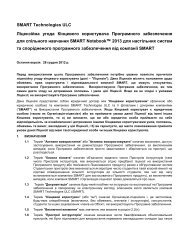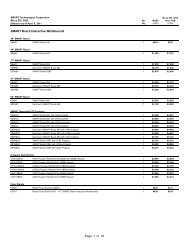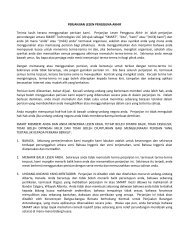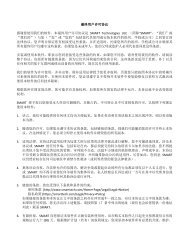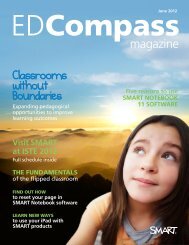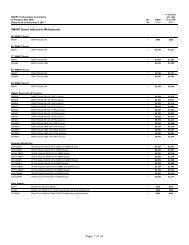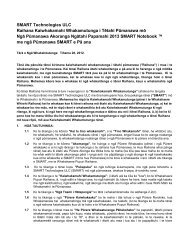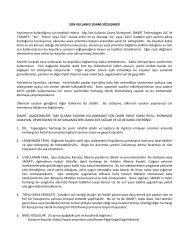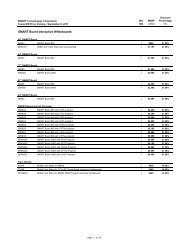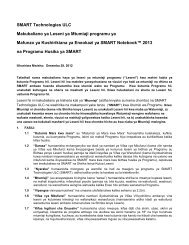magazine - SMART Technologies
magazine - SMART Technologies
magazine - SMART Technologies
You also want an ePaper? Increase the reach of your titles
YUMPU automatically turns print PDFs into web optimized ePapers that Google loves.
February 2012<br />
<strong>magazine</strong><br />
Making Global Connections<br />
without Leaving the Classroom<br />
Accountability.<br />
Words educators<br />
are constantly<br />
thinking about.<br />
By Danesa Jepson<br />
Changing the<br />
landscape of<br />
education<br />
Title I<br />
Connecting Title I<br />
schools to a future<br />
of opportunity!
FROM THE EDITOR<br />
Title I<br />
If you teach in a district where a large number of students<br />
participate in free or reduced-cost lunch programs, chances<br />
are you face different challenges when it comes to reaching<br />
your students in ways that will increase their success.<br />
In the United States today, high-poverty, low-performing schools<br />
and districts number in the thousands – and in some areas,<br />
those numbers increase each year. Thankfully, also increasing<br />
is the number of schools and districts defying long-held<br />
expectations about student achievement, demonstrating that<br />
disadvantaged students can achieve at the highest levels.<br />
As an educator – whether you’re a teacher, librarian, school<br />
administrator or technology coordinator – you have the<br />
power to inspire economically disadvantaged students and<br />
enable them to meet or exceed high academic standards.<br />
This issue, we focus on Title I. In the feature article on page<br />
14, read about the experiences of three innovative educators<br />
in Title I schools who have bridged their classrooms to the<br />
rest of the world by using <strong>SMART</strong> education solutions. On<br />
page 21, find out how to become a <strong>SMART</strong> Exemplary<br />
Educator and how you can win a <strong>SMART</strong> Board ® 885ix<br />
interactive whiteboard for your school. And in the <strong>SMART</strong><br />
Showcase School profile on page 22, learn how a rural<br />
elementary school in a high-poverty area has been able to<br />
provide its students with a global education right within its<br />
Tennessee-based classrooms.<br />
I hope this Title I issue helps you gather ideas, tools and<br />
resources to help you make a difference – to help your<br />
students achieve and your school succeed.<br />
Editorial<br />
Shari-Lynn Sare, Managing Editor<br />
Chrissie Chambers, Editor<br />
CONTRIBUTORS<br />
Kim Hamill<br />
Shari-Lynn Sare<br />
Danesa Jepson<br />
ART<br />
Vanessa Liang, Designer<br />
Photography on page 26 by Jon Pernul<br />
As always, you can e-mail any<br />
questions or feedback about<br />
EDCompass <strong>magazine</strong> or the blog to<br />
EDCompassfeedback@smarttech.com.<br />
Subscribe<br />
Receive monthly<br />
issues of EDCompass<br />
<strong>magazine</strong> right to your inbox.<br />
Sign up now for your<br />
complimentary subscription.<br />
Shari-Lynn Sare, MANAGING EDITOR<br />
© 2012 <strong>SMART</strong> <strong>Technologies</strong>. All rights reserved. EDCompass, <strong>SMART</strong> Board,<br />
<strong>SMART</strong> Exchange, <strong>SMART</strong> Notebook, LightRaise, <strong>SMART</strong> Response, <strong>SMART</strong><br />
Document Camera, <strong>SMART</strong> Slate, <strong>SMART</strong> Table, smarttech, the <strong>SMART</strong> logo, all<br />
product logos and all <strong>SMART</strong> taglines are trademarks or registered trademarks of<br />
<strong>SMART</strong> <strong>Technologies</strong> in the U.S. and/or other countries. All third-party product<br />
and company names are for identification purposes only and may be trademarks of<br />
their respective owners.<br />
2 | February 2012
contents<br />
04 Notes From<br />
the Field<br />
With Danesa Jepson<br />
Accountability. Scores.<br />
Words Educators Are<br />
Constantly Thinking About.<br />
06 Classroom<br />
Solutions<br />
New Products<br />
Announced!<br />
08 Classroom<br />
Content<br />
On the <strong>SMART</strong><br />
Exchange Website<br />
12 Classroom<br />
Content<br />
Sneak Peek – <strong>SMART</strong><br />
Notebook 11 Software<br />
Shape Image Fill and<br />
Customizable Creative Pen<br />
20 NEWS<br />
What’s Happening This Month<br />
Find out about <strong>SMART</strong>’s latest<br />
opportunities and happenings<br />
14 feature Article<br />
Changing the<br />
Landscape of Education<br />
24 Product spotlight<br />
An Added Dimension<br />
to Learning<br />
22 <strong>SMART</strong> Showcase<br />
School Profile<br />
Making Global Connections<br />
without Leaving the<br />
Classroom<br />
26 Ask AMY<br />
3D Tools for <strong>SMART</strong><br />
Notebook Software<br />
February 2012 | 3
NOTES FROM THE FIELD<br />
Accountability.<br />
scores.<br />
Danesa Jepson<br />
Seventh-Grade Language<br />
Arts Teacher and <strong>SMART</strong><br />
Exemplary Educator<br />
Oakdale, California<br />
Students<br />
not only<br />
learn more<br />
using<br />
<strong>SMART</strong><br />
products,<br />
but they<br />
want to<br />
learn more.<br />
Words Educators Are<br />
Constantly Thinking About.<br />
I teach at a traditional junior high school in California. We have<br />
850 students, many of whom would qualify as “target” students.<br />
Educators focus on these students, striving for continual progress and<br />
improved test scores. But my focus is my Title I students.<br />
For me, these students are more than just a score. They’re students in<br />
desperate need of connection, of learning in ways they enjoy. <strong>SMART</strong><br />
products do just that – they give teachers a way to deliver lessons that are<br />
motivating and engaging, while increasing those all-important grades.<br />
Having a <strong>SMART</strong> Board interactive whiteboard in my classroom didn’t<br />
automatically make learning more appealing for my students. That<br />
moment didn’t come until I created a lesson for a unit on affixes. It<br />
was an erase-to-reveal activity to help my Title I students easily focus<br />
on the concept. And yes, they better understood the concept, but<br />
more importantly, they wanted to keep learning. Students volunteered<br />
to go up to the interactive whiteboard. I had more hands in the air to<br />
answer questions. Students were excited to have immediate feedback<br />
while they were learning. They begged for more lessons that used<br />
the <strong>SMART</strong> Board interactive whiteboard so they could interact and<br />
play with it. This particular lesson and every one since has given my<br />
students the chance to enjoy learning, interact with subject matter and<br />
feel positive about their learning.<br />
When students are engaged, having fun and focused on learning, the end<br />
results are better grades and test scores, which makes everyone smile.<br />
4 | February 2012
Voice Box<br />
have your say....<br />
Your<br />
Vote<br />
What<br />
are your<br />
biggest<br />
challenges<br />
implementing<br />
technology<br />
into a<br />
Title I<br />
classroom?<br />
Vote now<br />
When it comes to providing instruction for<br />
English language learners, you said the biggest<br />
challenge is<br />
26%<br />
Finding the<br />
prep time<br />
required<br />
to create<br />
lessons<br />
Up Next<br />
Reducing anxiety for students with ELA needs<br />
by engaging and including them in classes<br />
16%<br />
Meeting state or provincial standards for<br />
achievement in English language proficiency<br />
14%<br />
Finding funding to purchase tools that<br />
will help English language learners<br />
6%<br />
All of the above<br />
20%<br />
Other<br />
18%<br />
Read the next issue of<br />
EDCompass <strong>magazine</strong>,<br />
where we spotlight science,<br />
technology, engineering<br />
and math (STEM) resources,<br />
programs and schools.<br />
February 2012 | 5
Classroom Solutions<br />
<strong>SMART</strong>’s product<br />
developers<br />
and product<br />
managers have<br />
been working<br />
countless hours<br />
on some new<br />
and exciting<br />
hardware<br />
and software<br />
products for your<br />
classroom. Here’s<br />
a glimpse.<br />
<strong>SMART</strong> Board<br />
800 series<br />
interactive<br />
whiteboard<br />
and four-touch<br />
interactivity<br />
Introduced in last month’s<br />
NEW PRODUCTS<br />
ANNOUNCED!<br />
Feature Advertorial<br />
product spotlight, four-touch interactivity is now offered on all shipping<br />
<strong>SMART</strong> Board 800 series interactive whiteboards and <strong>SMART</strong> Board<br />
8070i interactive displays. The 800 series currently enables two people to<br />
write, draw and interact with content and supports common multitouch<br />
gestures for Microsoft ® Windows ® 7 and Mac Snow Leopard operating<br />
systems. Four-touch functionality will increase opportunities for<br />
collaboration by giving your students more hands-on time. If you already<br />
have an 800 series interactive whiteboard, a no-charge upgrade will<br />
enable simultaneous freestyle interaction and object awareness for up<br />
to four users. The new functionality also enables two students to engage<br />
in multitouch gestures at the same time. Visit the <strong>SMART</strong> Exchange <br />
website to find <strong>SMART</strong> Notebook lessons compatible with four-touch<br />
functionality.<br />
3D Tools for <strong>SMART</strong> Notebook<br />
software<br />
A new plug-in for <strong>SMART</strong> Notebook software, 3D Tools enables<br />
you to import, view and manipulate 3D content in <strong>SMART</strong><br />
Notebook, without the need for additional hardware. You<br />
can manipulate 3D models and objects and label them from a<br />
variety of angles and perspectives, enabling increased student<br />
understanding of physical objects across a range of subjects. Read this month’s product<br />
spotlight to learn how 3D Tools for <strong>SMART</strong> Notebook software can immerse your<br />
students in a pedagogical world of exploration.<br />
6 | February 2012
Classroom Solutions<br />
<strong>SMART</strong> Notebook 11<br />
software<br />
The release of the most exciting<br />
version of our award-winning<br />
<strong>SMART</strong> Notebook software is<br />
just around the corner – and<br />
wow, is it big! This month and<br />
next, in our sneak peek section,<br />
we’re revealing one new feature<br />
of <strong>SMART</strong> Notebook 11. And<br />
then in April, we’ll give you<br />
an in-depth look at <strong>SMART</strong><br />
Notebook 11 software in the<br />
product spotlight. For now, we<br />
can tell you that with <strong>SMART</strong><br />
Notebook 11, you will be able<br />
to integrate online resources<br />
into <strong>SMART</strong> Notebook files by<br />
embedding a web browser. You’ll<br />
also have access to dictionary<br />
and translator widgets that<br />
enable you to handwrite a<br />
query, receive the answer and<br />
then move that answer to your<br />
<strong>SMART</strong> Notebook software<br />
page. And an avatar widget will<br />
let you bring dynamic, talking<br />
avatars into <strong>SMART</strong> Notebook 11<br />
and save them to the Gallery.<br />
LightRaise 40wi<br />
interactive projector<br />
The LightRaise interactive projector is a penenabled<br />
ultra-short-throw projector that can turn<br />
almost any surface into an interactive learning<br />
space. It can produce screen sizes up to 100"<br />
(254 cm) in a widescreen format, making it a<br />
flexible solution for any classroom. The interactive<br />
projector comes with <strong>SMART</strong> Notebook<br />
collaborative learning software, a rechargeable<br />
interactive pen, a convenient pen holder, USB and<br />
VGA cables and an easy-to-install wall mount.<br />
You and your students can use the interactive pen<br />
to write over applications and digital content,<br />
making lessons more engaging.<br />
The projector offers an affordable option for<br />
making your classroom interactive. And, it<br />
integrates seamlessly with other <strong>SMART</strong> products,<br />
including the <strong>SMART</strong> Response interactive<br />
response system, the <strong>SMART</strong> Document Camera <br />
and the <strong>SMART</strong> Slate wireless slate. The<br />
LightRaise projector is also protected by the<br />
<strong>SMART</strong> Projector Care program, which includes a<br />
three-year warranty and fast and reliable support.<br />
February 2012 | 7
CLASSROOM CONTENT<br />
on the<br />
<strong>SMART</strong><br />
<strong>SMART</strong> Notebook lessons<br />
With more than 15,000 ready-made or customizable <strong>SMART</strong> Notebook lessons on the <strong>SMART</strong> Exchange website,<br />
you can be sure your curriculum stays fresh and exciting. You’ll find a growing database of lesson content for all<br />
grades and subjects – many of which are standards correlated – created by classroom teachers or by <strong>SMART</strong>’s team of<br />
curriculum resource developers.<br />
You can also search for Common Core State Standards-correlated lessons for English language arts and math by<br />
clicking the Standards-Correlated Lessons button in the top navigation bar.<br />
Here are three lessons you can try with your students.<br />
Hatchet – A Companion to Gary<br />
Paulsen’s Book<br />
Students in grades 4–8 who are<br />
reading Hatchet by Gary Paulsen<br />
can dive further into the story with<br />
thinking maps and information<br />
about some of the animals<br />
introduced throughout the book.<br />
Cornstarch Quicksand<br />
Experiment<br />
Fifth-grade science students can<br />
learn about solids, liquids and<br />
gases. At the end of the lesson,<br />
students can do an experiment<br />
using cornstarch and water to<br />
mimic the properties of quicksand.<br />
Color Theory<br />
Art and design students in<br />
grades 6–8 can explore colors,<br />
the theory behind them and<br />
ways that colors are significant<br />
in our everyday lives.<br />
8 | February 2012
CLASSROOM CONTENT<br />
Exchange<br />
WEBSITE<br />
<strong>SMART</strong> Response question sets<br />
<strong>SMART</strong> Exchange also offers a growing number of <strong>SMART</strong> Response question sets, most of which are<br />
correlated to state and provincial curriculum standards. The website contains hundreds of activities for all<br />
subjects and grade levels.<br />
Try one of the following <strong>SMART</strong> Response question sets in your next class.<br />
Changing Matter<br />
Third-grade students can<br />
review the properties of matter<br />
and determine the various<br />
factors that cause it to change<br />
or evolve.<br />
Math Vocabulary<br />
Fifth- and sixth-grade students can<br />
test their knowledge of commonly<br />
used math terms, such as sum,<br />
product, quotient and difference.<br />
Is It Objective or Subjective?<br />
Eighth-grade students can read<br />
short passages and then test<br />
their ability to determine if<br />
what they read is objective or<br />
subjective. Students will also<br />
have the opportunity to defend<br />
their answers on paper.<br />
February 2012 | 9
CLASSROOM CONTENT<br />
<strong>SMART</strong> Table ® activities<br />
Developed specifically for early education classrooms, check out the growing number of activity packs for<br />
the <strong>SMART</strong> Table interactive learning center on the <strong>SMART</strong> Exchange website. You can search by<br />
topic, subject or grade level to access hundreds of activities for your <strong>SMART</strong> Table. You can use <strong>SMART</strong> Table<br />
activities with small groups to complement whole-class and individual learning experiences. Most activities<br />
correspond to a <strong>SMART</strong> Notebook lesson and <strong>SMART</strong> Response question set.<br />
Following are a few <strong>SMART</strong> Table activities you can try in your next class.<br />
Holidays<br />
With this sorting activity by<br />
Pronk, students can learn<br />
about different holidays and<br />
what each entails.<br />
Multiplication<br />
Students will find a variety<br />
of activities to practice their<br />
multiplication skills as they explore<br />
pictorial representations of<br />
multiplication and the relationship<br />
between multiplication and<br />
repeated addition.<br />
Vowels<br />
Students can practice short and<br />
long vowel sounds with two<br />
different activities.<br />
10 | February 2012
CLASSROOM CONTENT<br />
Videos<br />
Adding video can be an effective way of enhancing lessons and giving students a better understanding of<br />
subject matter. Among the wealth of resources available on the <strong>SMART</strong> Exchange website, you’ll find a variety<br />
of short video segments (2–3 minutes) on topics ranging from learning about World War II and ancient Greek<br />
myths to exploring landscapes and cities to learning about Mahatma Gandhi. Well-known publishers, including<br />
Discovery Education and Statusfirm, created the videos for students in middle to high school grades.<br />
Check out some of the newest videos from Discovery Education on <strong>SMART</strong> Exchange.<br />
Introduction to Quadratics<br />
Math students are led<br />
through an exploration of<br />
natural phenomena that can<br />
be explained with quadratic<br />
equations and functions.<br />
Roman Monumentalism and<br />
the Course of the Empire<br />
Students can see how the Romans<br />
used their ability to build massive<br />
structures to shock and intimidate<br />
their opponents. Roman builders<br />
were able to adapt to any<br />
circumstance and use whatever<br />
materials were at hand.<br />
The Sun, Solar System,<br />
Planetary Orbits and Gravity<br />
Science students can learn about<br />
gravity and how it keeps things<br />
in orbit from slamming into<br />
each other.<br />
February 2012 | 11
classroom content<br />
Last month, we introduced you to Audio Recording, a new<br />
feature of <strong>SMART</strong> Notebook 11 software, which will be available<br />
this spring. This month, we’d like to tell you about two other new<br />
features that can be used on their own or together to create fun<br />
activities for your students.<br />
Shape Image Fill<br />
You’ll soon have more options to dress up your<br />
lessons with shape image fill, a new feature that<br />
enables you to quickly and easily fit an image into<br />
any shape without having to resize the image. For<br />
example, you can use a photo of your students,<br />
from a vacation, of your pets – anything at all –<br />
and frame it in the shape.<br />
If you want to be really creative, take it a step<br />
further and make that framed image the stamp<br />
for your customizable creative pen.<br />
Customizable Creative Pen<br />
Once you have your image the way you want it, transfer<br />
it to your customizable creative pen, which is similar<br />
to the Magic Pen but customized with the ink of your<br />
choice. The stamps that appear using your customizable<br />
creative pen could be the image you created with the<br />
shape image fill tool or an object or drawing from a<br />
<strong>SMART</strong> Notebook software page. Essentially, it can be<br />
anything you want it to be.<br />
If you like, you can turn this into a fun reward system<br />
for your students. Pick one student each week to<br />
choose the shape image fill for that day or week’s<br />
customizable creative pen stamp.<br />
12 | February 2012
Classroom content<br />
<strong>SMART</strong> Notebook 11 Software<br />
How can I create this in <strong>SMART</strong> Notebook 11?<br />
It’s easy! Once you download the new software, follow these steps:<br />
1 2 3 4<br />
Shape Image Fill<br />
Select a shape from<br />
the top toolbar and<br />
drag it onto your<br />
page.<br />
Click the Properties<br />
tab on the side<br />
of your <strong>SMART</strong><br />
Notebook software<br />
page and select Fill<br />
Image.<br />
Browse your<br />
computer and select<br />
an image to fill the<br />
shape.<br />
Keep the image the<br />
same size or scale<br />
the image to fit into<br />
your shape.<br />
Customizable Creative Pen<br />
Once you have your shape image fill created, select the Creative Pen from the top toolbar<br />
Click the Properties tab on the side of your <strong>SMART</strong> Notebook software page and select Use a<br />
custom stamp image. The shape image fill that you just created will now appear as a stamp in your<br />
customizable creative pen.<br />
To create something entirely new for your customizable creative pen stamp<br />
Create your image or drawing on a <strong>SMART</strong> Notebook software page using any pen or color<br />
Click the Properties tab and select Use a custom stamp image. Click Select object and your<br />
curser will change to an eye dropper. Drag the eye dropper to your image or drawing and click<br />
directly into it. It will now appear as a stamp in your customizable creative pen.<br />
Save any stamp that you create to the toolbar by clicking Save Tool Properties found at the bottom<br />
of the Properties tab. The image will automatically appear in your toolbar.<br />
February 2012 | 13
feature article<br />
“Technology, with the guidance of teachers and<br />
librarians, can be a significant tool in expanding<br />
the world of any child who is isolated by poverty.”<br />
– Dr. Richard Long, Executive Director for Government Relations, National Title I Association<br />
Changing the Landscape<br />
of Education<br />
14 | February 2012
feature article<br />
By Kim Hamill<br />
Enriched education<br />
It’s becoming more challenging<br />
than ever to ensure every child<br />
experiences success in learning.<br />
Shrinking budgets, large class<br />
sizes and language barriers mean<br />
that teachers and education<br />
leaders must reach across these<br />
gaps to ensure students’ needs<br />
are met.<br />
Add the impact of poverty to<br />
that equation, and it becomes<br />
apparent that educators in Title<br />
I schools have even greater<br />
obstacles to achieving their goals.<br />
But teachers like Joy Weiss say<br />
that while it’s easy to focus on<br />
the difficulties, it’s the progress<br />
that matters.<br />
“While the challenges can<br />
become overwhelming, I think the<br />
important things to remember are<br />
the successes that are happening<br />
every day. Yes, I work hard<br />
and my students work harder<br />
than most in order to become<br />
comparable to their peers. What<br />
they can do each year shows their<br />
own dedication to learning and<br />
being successful,” she says.<br />
“These children work very hard<br />
each year and deserve the best,<br />
regardless of their income. They<br />
are just as capable and just as<br />
smart,” says Weiss, a <strong>SMART</strong><br />
Exemplary Educator who<br />
teaches third and fourth grade<br />
at Balsz Elementary in Phoenix,<br />
Arizona.<br />
February 2012 | 15
feature article<br />
Balsz is a Title I school where<br />
more than 90 percent of the<br />
students participate in free or<br />
reduced-priced meal programs.<br />
The school serves a large<br />
population of families with low<br />
socioeconomic status, including<br />
a refugee population. Weiss says<br />
that because of communication<br />
challenges in her classroom, she<br />
often has to teach language<br />
basics before she can introduce<br />
grade-level content.<br />
In 2010, she was recognized as<br />
the Arizona Teacher of the Year,<br />
an experience that Weiss says gave<br />
her a more global perspective on<br />
improving the effectiveness of<br />
education for her students.<br />
“Student achievement is a<br />
teacher’s number-one priority,<br />
next to instilling a love of selfdirected<br />
learning to students. I’m<br />
not referring to test scores and<br />
accountability to state agencies,<br />
but student achievement in terms<br />
of learning, exploring, enriching<br />
our understanding of the world<br />
16 | February 2012<br />
around us and becoming productive<br />
members of society that work<br />
together and create democratic<br />
communities of people that can<br />
move our society forward.”<br />
One of the ways that Weiss<br />
feels she is helping her students<br />
gain a deeper understanding of<br />
the world is through classroom<br />
technology, including the <strong>SMART</strong><br />
Board interactive whiteboard,<br />
<strong>SMART</strong> Document Camera,<br />
<strong>SMART</strong> Slate wireless slate and<br />
<strong>SMART</strong> Response interactive<br />
response system.<br />
Using these technology products<br />
has enabled her to present<br />
lesson content in more visual<br />
and interactive ways, which<br />
helps remove learning barriers in<br />
her classroom.<br />
She remembers when she taught<br />
first grade and was introducing the<br />
concept of alphabetizing. Using<br />
her interactive whiteboard and<br />
<strong>SMART</strong> Notebook collaborative<br />
learning software, she created a<br />
lesson showing a road that moved<br />
from A to Z. The road metaphor<br />
enabled her students to imagine<br />
that alphabetizing was like driving<br />
a car, and each letter had a stop.<br />
Her students were able to move<br />
their spelling words along the road,<br />
placing each word in its correct<br />
stop on the interactive whiteboard.<br />
“After that, when they needed to<br />
alphabetize on paper, it was done<br />
with relative ease. I could hear<br />
them talk about the ‘road’ that<br />
was in their head,” she says.<br />
Dr. Richard Long, Executive Director<br />
for Government Relations at<br />
the National Title I Association,<br />
says that technology, when used<br />
effectively, can help teachers<br />
provide differentiated instructional<br />
support to many students.<br />
“The National Title I Association<br />
views technology as a key tool to<br />
help teachers and administrators to<br />
enhance the educational experience<br />
for more children,” he says.<br />
Equal opportunities<br />
For Jennifer Harper, a fourth-grade<br />
teacher at Cavendish Town<br />
Elementary School in Proctorsville,<br />
Vermont, technology is the key to<br />
equitability in education.
“Technology brings in the equality<br />
to all my learners. My learners,<br />
who have a tough time sitting<br />
or standing still, can go to the<br />
<strong>SMART</strong> Board and complete an<br />
activity that meets their needs<br />
and the curriculum requirements.<br />
I take out the fear of getting<br />
something wrong in front of<br />
others by having students use<br />
their <strong>SMART</strong> Response remotes to<br />
enter answers,” Harper says.<br />
With 46 percent of its students<br />
qualifying for free and reducedcost<br />
lunch programs, Cavendish<br />
Elementary is a Title I school.<br />
However, three years ago,<br />
it became part of the Title I<br />
Schoolwide Program, so that all<br />
students could benefit from the<br />
additional resources, rather than<br />
just those students involved in the<br />
Title I program.<br />
Harper, who is the 2006 Vermont<br />
Teacher of the Year and a <strong>SMART</strong><br />
Exemplary Educator, says that<br />
<strong>SMART</strong> products play a big role in<br />
helping her reach all the students<br />
in her classroom. In addition to<br />
the <strong>SMART</strong> Board interactive<br />
whiteboard and the <strong>SMART</strong><br />
Response system, Harper also uses<br />
a <strong>SMART</strong> Document Camera and<br />
a <strong>SMART</strong> Slate wireless slate in<br />
her classroom.<br />
She has found these products<br />
are particularly helpful for<br />
engaging students with different<br />
learning styles. The interactive<br />
whiteboard and <strong>SMART</strong> Notebook<br />
software enhance learning for<br />
her kinesthetic learners, and<br />
the <strong>SMART</strong> Document Camera<br />
engages her visual and auditory<br />
learners by enabling a large focal<br />
point that spurs discussions. With<br />
the <strong>SMART</strong> Response system,<br />
everyone has the opportunity to<br />
answer questions without the fear<br />
of being wrong in front of others.<br />
But one of the biggest benefits<br />
that Harper has seen is how<br />
the <strong>SMART</strong> Board interactive<br />
whiteboard has opened up the<br />
world to her students.<br />
“During discussions, we can<br />
travel on Google Earth to ‘see’<br />
locations and bring the real world<br />
to each one of them. Many of our<br />
feature article<br />
families will never travel out of<br />
New England. Now our students<br />
can Skype, chat and e-mail<br />
around the world with others.<br />
Every year I have students who<br />
talk about traveling beyond New<br />
England and outside the United<br />
States. I know that the <strong>SMART</strong><br />
Board is opening doors for them.”<br />
Dr. Long says that bringing the<br />
world into the classroom is one of<br />
the biggest advantages of using<br />
technology in Title I schools.<br />
“An old adage is that a book<br />
can take one to places that they<br />
have never been and expose<br />
them to new ideas. Technology<br />
can do that with text, sound<br />
and visuals, all in an integrated<br />
format,” he says. “Technology,<br />
with the guidance of teachers and<br />
librarians, can be a significant tool<br />
in expanding the world of any<br />
child who is isolated by poverty.”<br />
Bright futures<br />
Another way that technology<br />
expands opportunities in Title I<br />
February 2012 | 17
feature article<br />
schools is by helping teachers<br />
make science and math lessons<br />
more engaging. Harper, who<br />
won the Presidential Award<br />
for Excellence in Mathematics<br />
and Science Teaching in 2003,<br />
says that giving young students<br />
experiences in these subjects can<br />
help encourage them to pursue<br />
these areas later in life.<br />
“As future members of our<br />
society, students have to see how<br />
math and science are a part of so<br />
many of our day-to-day jobs, as<br />
well as how they can be leaders<br />
in these areas,” Harper says.<br />
Creating leaders in science,<br />
technology, engineering and<br />
math is also one of Pamela<br />
Howell’s main goals. As Principal<br />
of Roosevelt-Perry Elementary<br />
School in Louisville, Kentucky,<br />
Howell believes in preparing<br />
students for 21st-century careers<br />
and opportunities.<br />
“What we’re trying to do is<br />
continue to break the poverty<br />
cycle by educating and giving kids<br />
an even chance. If they don’t have<br />
this at home, they’re going to<br />
experience it here and it’s going<br />
to hopefully get them interested<br />
in those types of jobs where they<br />
can continue their educational<br />
experiences through college or a<br />
career,” Howell says.<br />
Roosevelt-Perry is an inner-city<br />
school, with 96 percent of its<br />
students receiving free and<br />
reduced-priced lunches. It’s also<br />
a school with access to state-ofthe-art<br />
technology because it has<br />
Jefferson County Public School’s<br />
only designated elementary<br />
technology magnet program.<br />
This means that Roosevelt-<br />
Perry has enhanced the regular<br />
core curriculum program with<br />
components of technology,<br />
robotics and engineering to<br />
reinforce math and science skills.<br />
The school has a technology<br />
wing, dubbed the Technology<br />
Playground, where Roosevelt-<br />
Perry students get hands-on with<br />
lessons in STEM areas, whether it’s<br />
building robots, videoconferencing<br />
with NASA or exploring shapes<br />
on the <strong>SMART</strong> Table interactive<br />
learning center.<br />
The Technology Playground gives<br />
teachers and students access to<br />
computers, MP3 players, <strong>SMART</strong><br />
Board interactive whiteboards,<br />
<strong>SMART</strong> Slate wireless slates and<br />
other educational technology.<br />
Howell says when students get<br />
hands-on with lessons, it ensures<br />
that even if they are not confident<br />
in their abilities in these subjects,<br />
they can still experience success.<br />
“The <strong>SMART</strong> Board is just a<br />
great learning and teaching tool<br />
that evens the playing field for<br />
those students that may not<br />
be able to read or be great at<br />
math. Students can actually see<br />
examples and work through<br />
things at a touch of a fingertip,”<br />
Howell says.<br />
Dr. Long says that in high-poverty<br />
areas, many students have the<br />
perception that they can’t excel<br />
in these subjects, but having Title<br />
I schools provide STEM programs<br />
can have a big impact on<br />
students’ futures.<br />
18 | February 2012
feature article<br />
“For some students, focusing on<br />
STEM helps them to break the<br />
cycle of poverty, but the reality is<br />
that there are few programs that<br />
make use of STEM areas linking the<br />
academics to the work world over<br />
the course of an academic career.<br />
This is especially true in the highpoverty<br />
schools where we find that<br />
even more students believe that<br />
they do not have that ‘math gene’<br />
to succeed,” Long says.<br />
“STEM could be a very useful<br />
and wide ranging tool in our<br />
schools to break the cycle of<br />
poverty, but much more needs to<br />
be done to take this idea from a<br />
few good programs to an area of<br />
systemic change.”<br />
Howell believes that exposing<br />
students to STEM subjects<br />
at a young age will inspire a<br />
new generation of engineers,<br />
mathematicians and scientists<br />
in Louisville. That’s why the<br />
school has an affiliation with<br />
the University of Louisville’s<br />
engineering program.<br />
Roosevelt-Perry held a career<br />
day where students from both<br />
programs can see the work<br />
each is doing in robotics and<br />
engineering.<br />
According to Howell, when the<br />
elementary students saw what the<br />
university students were working<br />
on, they said, “Oh my goodness,<br />
those are the basic robotic skills<br />
that we just learned!”<br />
In addition to the Technology<br />
Playground, every Roosevelt-Perry<br />
classroom has a <strong>SMART</strong> Board<br />
interactive whiteboard, a <strong>SMART</strong><br />
Document Camera, a <strong>SMART</strong><br />
Response interactive response<br />
system, <strong>SMART</strong> Slate wireless<br />
slates and a <strong>SMART</strong> Audio<br />
classroom amplification system.<br />
The school also has a professional<br />
development room where all<br />
district teachers are trained to use<br />
the <strong>SMART</strong> products and other<br />
educational technology.<br />
“Our attendance has improved<br />
and our kids are just more<br />
engaged. Student expectations,<br />
higher order thinking, and the<br />
quality of work that’s being<br />
produced here is totally different<br />
than it was seven years ago,”<br />
Howell says, referring to the<br />
transformation the school has<br />
undergone since becoming a<br />
technology magnet school.<br />
While the challenges of working<br />
in a Title I school are big, the<br />
successes can be bigger when<br />
educators use innovative strategies<br />
to teach. Weiss sums it up nicely:<br />
“If we are not providing students<br />
quality instruction with proper use<br />
techniques with technology, these<br />
students will not have the same<br />
chance of contributing to society<br />
in a meaningful way. Education<br />
and technology are not luxuries to<br />
be gained, but the right of every<br />
person to become productive,<br />
educated, lifelong learners.”<br />
Education<br />
and<br />
technology<br />
are not<br />
luxuries to be<br />
gained,<br />
but the right<br />
of every<br />
person to<br />
become<br />
productive,<br />
educated,<br />
lifelong<br />
learners.<br />
Joy Weiss<br />
Teacher<br />
Balsz Elementary<br />
Phoenix, Arizona<br />
February 2012 | 19
NEWS<br />
What’s<br />
Happening<br />
This Month<br />
Want to win a <strong>SMART</strong> Board 885ix<br />
interactive whiteboard system?<br />
Enter our STEM contest for a chance to win an 885ix,<br />
which will help you engage students in learning and<br />
inspire them to explore the world around them.<br />
Read the terms and conditions and enter for your<br />
chance to win!<br />
Discover new ways to bring math and<br />
science to life in the classroom<br />
Attend <strong>SMART</strong>’s webinar to hear educators discuss how<br />
they’ve successfully used <strong>SMART</strong> products to further<br />
engage students in STEM subjects. This complimentary<br />
one-hour session on February 29 will explore holistic and<br />
integrated approaches to the implementation of <strong>SMART</strong><br />
products in classrooms and suggest new ways to deliver<br />
visual and interactive math and science lessons that spark<br />
a lasting interest in STEM.<br />
Register now for this webinar taking place Wednesday,<br />
February 29 at 3:00 p.m. (ET).<br />
20 | February 2012
NEWS<br />
Become a <strong>SMART</strong> Exemplary<br />
Educator (SEE)<br />
Would you like to join the global network<br />
of <strong>SMART</strong> Exemplary Educators who are<br />
transforming teaching and learning with the<br />
help of <strong>SMART</strong>? Our popular SEE program brings<br />
together teachers, technology coordinators and<br />
administrators who lead the way in using <strong>SMART</strong><br />
products to engage students and improve learning<br />
outcomes.<br />
Through March 31, you’re invited to complete a<br />
SEE program application. In the application, you will<br />
need to highlight your commitment to developing<br />
effective education practices and sharing them with<br />
other educators. You will also need to provide a<br />
reference letter from a school administrator and<br />
a video of yourself presenting part of a <strong>SMART</strong><br />
Notebook lesson that you created.<br />
Congratulations!<br />
EDCompass <strong>magazine</strong> would like to congratulate the<br />
2012 SEEs of the Year:<br />
• Michael McGowan, Supervisor of Technology,<br />
Lincoln Elementary School District, Calumet<br />
City, Illinois<br />
Participate in the world’s first<br />
digital spelling competition!<br />
Enter your class or school – or even yourself – in the<br />
Spellathon, a free, global, English language event.<br />
The spelling competition, featuring Stephen Fry, is<br />
open to children and adults worldwide through the<br />
beginning of March. The bee-themed Spellathon<br />
lets you and your students practice spelling using<br />
interactive games and quizzes.<br />
For even more spelling fun, download our free<br />
Spellathon <strong>SMART</strong> Notebook file from <strong>SMART</strong><br />
Exchange, which gives you resources for the<br />
Spellathon and instructs you how to navigate to the<br />
interactive whiteboard game.<br />
You can also download free Spellathon mobile<br />
apps and find free digital school packs on<br />
Spellathon’s website – there’s a pack for primary<br />
and secondary schools, as well as university level<br />
and individual adults and students. The packs<br />
contain guides, word lists, games, posters and<br />
e-mail templates for informing parents about the<br />
competition. For complete details on the Spellathon,<br />
review the competition’s terms and conditions and<br />
then get spelling!<br />
• Alexandra Dunn, Speech and Language<br />
Pathologist, Upper Canada District School<br />
Board, Ontario, Canada<br />
Learn more about the SEE program pathways and<br />
how you can apply to join this group of skilled and<br />
dedicated educators.<br />
February 2012 | 21
<strong>SMART</strong> Showcase school PROFILE<br />
Making Global Connections<br />
without Leaving the Classroom<br />
By Kim Hamill<br />
But even though this Title I School is in a low-income<br />
area, students receive a high-quality education. In fact,<br />
Flynn and the rest of the school’s educators work hard<br />
to help students with the social issues they face and<br />
ensure they receive a global education.<br />
They accomplish these goals using products such as<br />
<strong>SMART</strong> Board interactive whiteboards, <strong>SMART</strong><br />
Response interactive response systems, the<br />
<strong>SMART</strong> Document Camera and <strong>SMART</strong> Table<br />
interactive learning center. The entire school<br />
district has standardized on <strong>SMART</strong> products.<br />
“<strong>SMART</strong> products are letting us present a global<br />
aspect of the world in our classrooms, and that has<br />
been a huge, huge advantage to us here with our kids<br />
being so out of the real-world picture,” Flynn says.<br />
“We’ve got a lot of students who have never and<br />
will never venture outside of this area that they’re<br />
living in. They don’t go to museums, they don’t go on<br />
vacations. They’ve never been out of this little area –<br />
let alone out of the state or out of the country – to be<br />
exposed to what is out there in the world.”<br />
According to Principal David Flynn, this challenge is<br />
one of the main reasons that <strong>SMART</strong> products are<br />
critical to teaching and learning success at Westside<br />
Elementary School, a <strong>SMART</strong> Showcase School in<br />
Westmoreland, Tennessee.<br />
Rich in learning experiences<br />
Located in a rural, high-poverty area of the state,<br />
Westside Elementary School serves 325 students from<br />
pre-kindergarten to fifth grade – 300 of whom qualify<br />
for free or reduced-cost lunch programs.<br />
And because Westside students haven’t had<br />
opportunities to explore the world, more background<br />
information is often required about a lesson before<br />
teachers can begin teaching.<br />
“Their world is so closed in when they come to<br />
us – there is no other way to really get them global<br />
experience,” Flynn says. “We have a lot of social factors<br />
we have to deal with here. But on top of that, when<br />
you try to teach a lesson … about where the President<br />
lives and they have no clue where Washington, DC, is,<br />
where Virginia is, where that’s at in the United States.<br />
The global aspect that <strong>SMART</strong> [products] bring to the<br />
entire class has revolutionized our students. It’s truly<br />
been an altering situation.”<br />
Kindergarten teacher Leslie Goad agrees,<br />
saying that providing her students with a visual,<br />
22 | February 2012
<strong>SMART</strong> Showcase school PROFILE<br />
“I’ve spent a lot of money over the years using Title<br />
I funds and sometimes you wonder, ‘Did I really<br />
get out of it what I spent?’ But I truly believe with<br />
<strong>SMART</strong>, you get way more than what it costs.”<br />
David Flynn<br />
Principal<br />
Westside Elementary School<br />
Westmoreland, Tennessee<br />
interactive way to connect to information makes<br />
teaching the basics much easier.<br />
“Our kids come to us at all different levels, and where<br />
they are is unbelievable. You have some that have never<br />
held a crayon, you have some that have never been<br />
around other children, you have some that have never<br />
been separated from their parents – so they come to<br />
you having lots and lots and lots of needs,” Goad says.<br />
Success for everyone<br />
Westside Elementary is an inclusion school, so some of<br />
Goad’s students have special needs. She has found that<br />
<strong>SMART</strong> products enable these students to participate in<br />
activities with her higher-functioning students, creating<br />
a collaborative environment that’s beneficial for all.<br />
“Our inclusion program merged with our technology<br />
program to get student scores up, and we’ve made<br />
some real progress with our special needs kids in that<br />
area. So, at one time, we were about 87 percent<br />
below proficient for our special needs kids, and that<br />
currently is riding around 17 percent,” Flynn says.<br />
“We’ve made that gain in the last five years, so that’s<br />
pretty huge. We received a commendation from the<br />
state of Tennessee for our progress, so we’ve made<br />
some real progress through inclusion merged with our<br />
<strong>SMART</strong> products.”<br />
Fifth-grade teacher Ashley Shouse says that with <strong>SMART</strong><br />
products, no learner is left behind. The products appeal<br />
to every learning style, enabling her to find creative ways<br />
to help her students understand concepts.<br />
She is currently tutoring a student who struggles with<br />
many math and reading concepts. At first, she was<br />
struggling to help him understand the concepts, until<br />
she spoke to the student’s mother and learned the<br />
student was interested in computer programming.<br />
“I thought, ‘How is this kid, you know, who’s into<br />
computer programming failing fifth-grade math and<br />
English?’ So I started finding tons of stuff with my<br />
<strong>SMART</strong> Board and my iPad, and he’s definitely passing<br />
now. You had to teach it to him in a whole different way<br />
and he gets it,” Shouse says.<br />
Although the challenges of Westside educators are<br />
great – sometimes before Shouse and Goad can<br />
start teaching, they have to help a student who<br />
hasn’t had breakfast or a child who’s been awake<br />
all night – Flynn says that <strong>SMART</strong> products have<br />
helped these students reach out and connect with<br />
the world at large.<br />
“I’ve spent a lot of money over the years using Title<br />
I funds and sometimes you wonder, ‘Did I really<br />
get out of it what I spent?’ But I truly believe with<br />
<strong>SMART</strong>, you get way more than what it costs.”<br />
Your school can become a <strong>SMART</strong> Showcase School and be recognized for<br />
using <strong>SMART</strong> education solutions to create exceptional learning environments.<br />
If selected, your school will receive exclusive membership benefits and<br />
opportunities. It will have an opportunity to share its success story and serve<br />
as a host site for other educators who want to find out about the benefits of<br />
implementing <strong>SMART</strong> products. Learn more.<br />
February 2012 | 23
PRODUCT SPOTLIGHT<br />
And you can also zoom in and<br />
enter the 3D scene. Just imagine<br />
the look on your students’ faces<br />
as a 3D image of the Acropolis in<br />
Athens seemingly zooms toward<br />
them, and they can enter the<br />
famed monument and have their<br />
imaginations take over!<br />
An Added Dimension<br />
to Learning<br />
3D Tools for <strong>SMART</strong> Notebook software<br />
Some things look just fine when<br />
they are flat.<br />
The Mona Lisa, for instance,<br />
would never be considered boring<br />
because it’s two-dimensional. But,<br />
then again, the Mona Lisa is an<br />
exception to the rule!<br />
But the visual content you use in<br />
your classroom – clouds, blood<br />
cells, planets, the Leaning Tower<br />
of Pisa or even a fish – is much<br />
more dynamic when your students<br />
can see its spatial dimensions and<br />
explore it in-depth.<br />
With the new 3D Tools for<br />
<strong>SMART</strong> Notebook software, you<br />
can immerse students in 3D lessons,<br />
enabling them to investigate lesson<br />
content from multiple angles.<br />
Available in spring 2012, this<br />
plug-in for <strong>SMART</strong> Notebook 11<br />
collaborative learning software<br />
will enable you to import and<br />
manipulate 3D content seamlessly,<br />
and add an exciting dimension to<br />
teaching and learning.<br />
In-depth explorations<br />
Experiential learning can be an<br />
effective way of helping students<br />
understand a concept or lesson,<br />
but bringing in artifacts or taking<br />
fields trips is not always practical<br />
or affordable. 3D Tools for <strong>SMART</strong><br />
Notebook enables students to<br />
better understand physical objects<br />
across a range of subjects and to<br />
make connections between ideas –<br />
without leaving the classroom.<br />
With this plug-in, you can<br />
show a 3D image or animation<br />
on a <strong>SMART</strong> Board interactive<br />
whiteboard, label it, and rotate and<br />
interact with it using your fingers.<br />
Once inside a scene, you can<br />
navigate through the internal<br />
details of the models. For<br />
example, if navigating the interior<br />
of a home, your students would<br />
see the fine details, such as<br />
furniture and decorations.<br />
An array of content<br />
3D Tools for <strong>SMART</strong> Notebook<br />
software is licensed-based software<br />
that includes 11 educational 3D<br />
objects in the Gallery for <strong>SMART</strong><br />
Notebook, and you can find an<br />
additional 69 3D objects on the<br />
<strong>SMART</strong> Exchange website.<br />
Also, Google 3D Warehouse<br />
is searchable right from <strong>SMART</strong><br />
Notebook software, giving you<br />
instant access to thousands of 3D<br />
objects. You and your students can<br />
also create and import your own<br />
3D objects into <strong>SMART</strong> Notebook<br />
with Google SketchUp. And<br />
because 3D Tools for <strong>SMART</strong><br />
Notebook is nonstereoscopic<br />
technology, students do not need<br />
to wear 3D glasses.<br />
Watch a video about 3D Tools for<br />
<strong>SMART</strong> Notebook software and<br />
download the 30-day trial to see<br />
how this new plug-in can bring<br />
an added dimension to learning in<br />
your classroom.<br />
24 | February 2012
PRODUCT SPOTLIGHT<br />
writes Dr. Bamford, citing results<br />
from the study.<br />
What you need to know about our<br />
new add-on to <strong>SMART</strong> Notebook.<br />
What’s unique about 3D Tools?<br />
Many companies are developing<br />
3D content these days, so what<br />
makes 3D Tools for <strong>SMART</strong><br />
Notebook software special? Here<br />
are just a few of the extraordinary<br />
things you can do with 3D Tools:<br />
• Access and manipulate 3D<br />
content right within <strong>SMART</strong><br />
Notebook software<br />
• Navigate through the<br />
internal details of 3D models<br />
• Disguise a 3D object as a<br />
magic hat and click to reveal it<br />
• Label objects and the labels<br />
will remain affixed, even when<br />
objects are rotated and moved<br />
• Write in digital ink over 3D<br />
objects or layer them with<br />
2D objects<br />
• Rotate objects by moving<br />
them on a single axis or on<br />
multiple axes<br />
Studying 3D in the classroom<br />
The 3D in Education White<br />
Paper, from Texas Instruments ,<br />
explores the idea of using 3D as a<br />
teaching and learning tool. Written<br />
by Dr. Anne Bamford, Director<br />
of the International Research<br />
Agency, the paper focuses on<br />
a European study examining<br />
stereoscopic 3D (3D requiring<br />
glasses) and its impact on student<br />
engagement and understanding.<br />
“The research results suggested that<br />
the 3D animated models were able<br />
to represent information in the most<br />
economical manner to facilitate<br />
learning and comprehension,<br />
thus simplifying complex, abstract<br />
and impossibly large amounts of<br />
information into a coherent form,”<br />
writes Dr. Bamford.<br />
When it comes to academic results,<br />
the study also showed that 3D had<br />
a marked positive effect on learning,<br />
recall and test performance.<br />
“Under experimental conditions,<br />
86% of pupils improved from the<br />
pre-test to the post-test in the 3D<br />
classes, compared to only 52%<br />
who improved in the 2D classes,”<br />
Google and 3D<br />
Google 3D Warehouse and Google<br />
SketchUp are two great – and free<br />
– resources for incorporating 3D<br />
into your classroom. Between these<br />
two resources, you not only can<br />
create 3D objects, such as vehicles,<br />
buildings or animals, but also find,<br />
share, store and collaborate on<br />
3D models.<br />
A few of our favorite 3D<br />
models available in Google 3D<br />
Warehouse are<br />
Notre Dame de Paris<br />
Playground<br />
What a teacher says<br />
Statue of Liberty<br />
SKPRbot<br />
I teach in a low-income school. These students don’t travel<br />
outside their local area. With 3D, they get the whole visual,<br />
not just a flat shape. [For] example, the Roman Colosseum can<br />
be shown as 3D, including where the spectators sat, where the<br />
gladiators dueled. Animals that can’t normally be brought into<br />
the classroom can come alive via 3D. Students can’t get this<br />
kind of experience with flat pictures.<br />
Dorothy Johnston<br />
Sixth-Grade Teacher<br />
Monte Vista Elementary School<br />
Montclair, California<br />
February 2012 | 25
PRODUCT SPOTLIGHT<br />
Ask<br />
Amy<br />
Being the product manager for<br />
3D Tools for <strong>SMART</strong> Notebook<br />
software means that Amy<br />
Dewis is often surrounded by<br />
3D images and animations. An<br />
avid floor hockey player, Amy<br />
is the perfect person to explain<br />
how 3D Tools can help teachers<br />
meet their classroom goals –<br />
pun intended! Here’s what she<br />
had to say.<br />
Why is 3D Tools for <strong>SMART</strong><br />
Notebook software a great<br />
solution for a budgetconscious<br />
school?<br />
3D Tools is a great alternative to<br />
3D projection systems that require<br />
3D glasses for each student. In<br />
addition, for those schools that<br />
can’t afford document cameras for<br />
every room, 3D Tools brings 3D<br />
content to life right on the <strong>SMART</strong><br />
Board interactive whiteboard – at<br />
a fraction of the cost.<br />
26 | February 2012
PRODUCT SPOTLIGHT<br />
Why is this better than using<br />
another 3D viewer?<br />
The ability to access and<br />
interact with 3D content<br />
from right within <strong>SMART</strong><br />
Notebook lessons is essential<br />
for keeping students’ attention.<br />
No application switching is<br />
required, so teachers can keep<br />
students engaged and the<br />
lesson flowing smoothly.<br />
What are your favorite<br />
aspects of this product?<br />
The fact that it’s so easy to<br />
use – you just drag and drop<br />
from the Gallery in <strong>SMART</strong><br />
Notebook. Also, because it<br />
supports multiple file formats,<br />
there are thousands of pieces<br />
of content to choose from. The<br />
possibilities are endless.<br />
Can you tell us what’s<br />
coming next?<br />
3D Tools is currently only<br />
available for Microsoft Windows,<br />
but it will be available this spring<br />
for Mac operating systems.<br />
We are also continually adding<br />
more 3D content to the <strong>SMART</strong><br />
Exchange website, so keep<br />
checking back!<br />
February 2012 | 27
Now there’s an easy<br />
way to assess learning<br />
in any classroom<br />
With <strong>SMART</strong> Response interactive response systems,<br />
teachers can assess learning, enhance instruction and<br />
improve student outcomes. <strong>SMART</strong> offers five models,<br />
making it easy for you to find the right assessment<br />
tool for every type of learning environment.<br />
Explore your choices today at smarttech.com/response.



